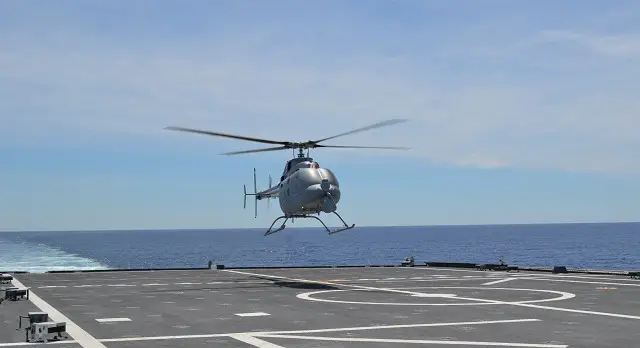Breaking news
U.S. Navy’s autonomous helicopter’s enhanced capabilities support advanced combat role.
| 2017
|
|
|||
 CHANGI NAVAL BASE, Singapore (May 29, 2015) An MQ-8B Fire Scout unmanned aircraft system, left, and an MH-60R Sea Hawk helicopter are displayed on the flight deck of the littoral combat ship USS Fort Worth (LCS 3) while the ship is moored pierside in Singapore. Fort Worth is on a 16-month rotational deployment in support of the Indo-Asia-Pacific-Rebalance. (U.S. Navy photo by Lt. James Arterberry/Released CHANGI NAVAL BASE, Singapore (May 29, 2015) An MQ-8B Fire Scout unmanned aircraft system, left, and an MH-60R Sea Hawk helicopter are displayed on the flight deck of the littoral combat ship USS Fort Worth (LCS 3) while the ship is moored pierside in Singapore. Fort Worth is on a 16-month rotational deployment in support of the Indo-Asia-Pacific-Rebalance. (U.S. Navy photo by Lt. James Arterberry/Released |
|||
|
|
|||
| Fire Scout 2017 milestones: January through November – Two radar equipped MQ-8Bs were operationally deployed aboard the independence-class Littoral Combat Ship USS Coronado (LCS-4). Operating in the 7th Fleet’s area of responsibility in 2017, the Fire Scout’s supported multiple bilateral and multilateral exercises with 16 partner nations. Fire Scout provided USS Coronado with an organic, persistent ISR&T capability- a critical enabling component of distributed maritime operations. Fire Scout’s over the horizon targeting also enabled the USS Coronado to showcase its strike capability in the surface warfare mission. April - MQ-8C Fire Scout made its first flight from a U.S. Navy independence-class Littoral Combat Ship, USS Montgomery (LCS 8). The two week, at-sea event allowed the U.S. Navy to test the MQ-8C’s airworthiness and expand the aircraft’s operational envelope from an LCS. May – U.S. Navy personnel successfully completed a two-part demonstration with two radar-equipped MQ-8B Fire Scouts. The demonstration proved Fire Scout’s ability to hand off controls from one mission control system to another as they operated between Naval Base Ventura County, California, and Naval Auxiliary Landing Field San Clemente Island, California. Fire Scout also proved the CONOPS for live streaming of ISR&T data to the amphibious assault ship, USS America (LHA 6) and embarked Marine Expeditionary Unit. The demo concluded with Fire Scout providing MUM-T laser-designation for a MH-60S Hellfire missile shot. Training and rehearsal for the demonstration was conducted on a Northrop Grumman Fire Scout simulator used for operator training. August - A radar-equipped MQ-8B Fire Scout participated in a bilateral maritime exercise, Pacific Griffin, providing real-time targeting data to the independence-class Littoral Combat Ship, USS Coronado (LCS-4). The ship fired a Harpoon Block 1C missile, successfully hitting a surface target significantly beyond the ship’s visual range. Fire Scout’s expanding ISR&T capability is adding lethality to the U.S. Navy’s distributed maritime operations doctrine. October – The Fire Scout payload, the AN/DVS-1 Coastal Battlefield Reconnaissance and Analysis (COBRA), airborne mine detection system completed the first phase of its initial operational test and evaluation. The alternate Fire Scout sensor payload can detect beach zone mines in the daytime, provide reconnaissance for amphibious landing forces and provide precision navigation to amphibious vehicles coming ashore. This enhanced mission capability will enable the mine countermeasure variant of LCS to grow its mission capability. December – For the first time, Helicopter Squadron (HSC 23) integrated a radar-equipped MQ-8B Fire Scout into a carrier air wing strike package with Naval Air Warfare Development Center at Naval Air Station Fallon, Nevada. The goal was to integrate Fire Scout organic ISR&T capability in a multi-level training environment to increase autonomous systems in a distributed maritime environment. “Our mission engineering approach allows us to anticipate and solve some of the Fleet’s toughest problems with today’s MQ-8B Fire Scouts,” said Jack Thomas, mission engineering director, Fire Scout, Northrop Grumman Aerospace Systems. “Meanwhile, MQ-8C’s increased capability will enable the U.S. Navy to address emerging threats with new capabilities like Link-16 for collaborative engagement with net-enabled weapons in the near future.” Fire Scout’s noteworthy year of performance is a testament to the versatility and dynamic capability the autonomous system brings to the U.S. Navy. The Fire Scout system continues to perform in existing and new mission areas and will play an increasingly larger role for tactical maritime users in the coming year. |
|||


























